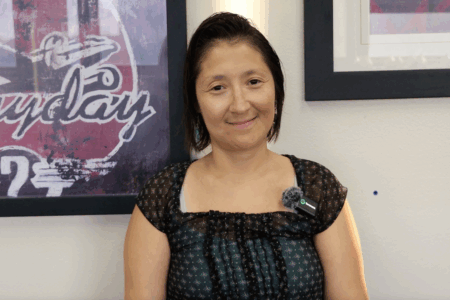
Share On Social!
The U.S. Centers for Disease Control & Prevention’s Project Firstline program offers training and educational resources on various infection control topics, including risk recognition and infection control basics related to COVID-19.
These training and educational resources are designed for all healthcare workers, no matter their role or educational background.
Join us as Salud America! explores Project Firstline’s interactive infection control resources for healthcare workers through a three-part series on, “What’s Wrong with This Picture?”
Part 1 tackled the emergency room. Part 3 will focus on an outpatient exam room.
Today, we will address the nurse’s station.
Can You Recognize Infection Control Risks?
Healthcare workers must be aware of where germs live and how they can spread to surfaces and people.
In the picture below, there are four problems that may cause germs to spread. Can you identify these issues and how to fix them?

Show Me the Answers!
Your hands can get dry during a long shift of practicing proper hand hygiene, but keeping a shared tub of lotion at the nurse’s station presents an opportunity for germs to spread.
Each time someone puts their hands in the tub of lotion, they can spread bacteria that can grow and multiply in the lotion. Those germs can then spread to others every time the lotion is used.
In fact, shared tubs of lotion have been linked to disease outbreaks in healthcare!
Only use hand lotions that are approved by your facility to ensure that they won’t interfere with hand sanitizers, and in this case, sharing isn’t caring.

Can you find the next infection control risk?
Food is correct! While healthcare workers can work up a strong appetite meeting the demands of colleagues and patients, food shouldn’t be left at the nurse’s station because it could become contaminated by blood or body fluid.
Additionally, if food gets on dry surfaces and isn’t properly cleaned, it can cause germs to grow.
Please eat in designated areas for your and others’ safety.

If you are familiar with handling needles, you may have already spotted the next infection control risk.
That’s right – certain tasks, such as preparing or administering a vaccine, should not be conducted in a crowded and potentially germy place, like the nurse’s station.
Instead, medications and vaccines should be prepared in a clean, designated space to minimize the risk of infection.

Finally, while we love a pair of gloves, you should only wear Personal Protection Equipment (PPE) when necessary.
The same pair of gloves, for instance, should not be worn for multiple patients or tasks. To prevent the spread of germs, remove and throw away your gloves between patients or tasks, and always perform hand hygiene after you take them off.
In the picture below, the nurse could potentially be spreading germs to other patients, colleagues, surfaces, and medical devices by continuing to wear contaminated gloves.

Why Use Project Firstline Interactive Resources?
You can help stop infections when you recognize the risk for germs to spread!
These interactive resources are a great way to refresh your infection control knowledge and skills.
Additionally, CDC Project Firstline offers short and easy to understand training modules that can help you earn continuing education credit.
We believe that you have the power to stop the spread of infectious diseases, including COVID-19, and protect vulnerable patients and communities, such as Latinos!
What Can You Do to Promote Infection Control in Your Healthcare Setting?
Help keep yourself, your colleagues, and your patients safe from infectious disease threats, such as COVID-19, by building on your infection control knowledge!
To show your dedication, sign this pledge to complete an infection control training or activity through CDC’s Project Firstline!
You can also share infection control training opportunities with healthcare colleagues via LinkedIn with our Project Firstline social media toolkit.
You can access more information about infection prevention and control in healthcare by visiting resources from CDC Project Firstline.
Salud America! at UT Health San Antonio is working with the National Hispanic Medical Association to bring Project Firstline infection control educational content to healthcare workers, so they are equipped with the knowledge they need to protect themselves, their facilities, and their patients (Latinos and all communities) from infectious disease threats in healthcare settings.
Check out some of the articles from this partnership:
- What is Project Firstline?
- What is the Goal of Infection Prevention and Control in Healthcare Settings?
- What’s a Virus?
- What is Ventilation and Why Does It Matter?
- Contact Time: What is It and How Does it Impact Infection Control?
- The Surprising Difference Between Cleaning and Disinfection
- What’s a Respiratory Droplet and Why Does It Matter?
- We Need to Talk about Hand Hygiene Again
- Why are Gowns, Gloves, and Eye Protection Recommended for COVID-19?
Check out some of the Latino healthcare workers who are heroes for infection control:
- Anna Valdez: Tackling Infection Control with Education from Classroom to Clinic
- Wanda Montalvo: Preventing Infections in Community Health Centers, Latino Communities
- Ricardo Correa: Endocrinologist and Infection Control Leader for the Latino Community
Learn More about Project Firstline!
Editor’s Note: This article is part of a collaboration between Salud America!, the National Hispanic Medical Association, and the CDC’s Project Firstline. To find resources training materials, and other tools to bolster knowledge and practice of infection control, visit Project Firstline and view Salud America!’s infection control content.
Explore More:
Healthy Families & SchoolsBy The Numbers
142
Percent
Expected rise in Latino cancer cases in coming years



